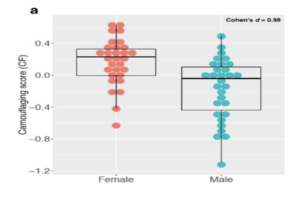For more neuroscience news, check out the UnknownNow, a student organization for neuroscience research and service,

Source: chenspec, Pixabay
Among neurodevelopmental disorders, autism stands out both as a complex and a prominent condition, affecting 1 in 6 children ages 3-17 in the United States15. The condition is defined by impairments to communication and social skills, and it is common for people with autism to engage in various repetitive behaviors like self-stimulation, repeating phrases, and twirling². Autism Spectrum Disorder (ASD), or autism, encompasses a wide range of symptoms and behaviors. Recent advances in neuroscience have provided insights into the neurological basis of autism. Through neuroimaging studies, researchers have seen structural differences in the brains of neurodivergent individuals, like those with ASD, compared to neurotypical individuals³. Researchers are also starting to see how genetic factors contribute to the brain structural differences seen in neurodivergent individuals. One such study conducted at the University of California Los Angeles (UCLA) School of Medicine has shown how gene variants and features from other diagnostic methodologies including eye-tracking and electroencephalography (EEG) were associated with features in the image of the brain3. ASD is known to have a strong genetic component, so understanding the genetic basis of the condition will help scientists understand individuals’ risk for autism, and may also help identify therapeutic targets to alleviate certain symptoms. This article outlines our current knowledge about how the brain differs – in structure and function – for people with autism and what genetic factors are at play.
Structural brain changes
Studies using neuroimaging techniques such as magnetic resonance imaging (MRI) have consistently shown differences in total brain volume between individuals with ASD and neurotypical individuals. One of the most consistently reported findings in toddlers with ASD is an increase in total brain volume compared to neurotypical children. This enlargement, ranging from 5% to 10%, has been documented across various studies using structural magnetic resonance imaging (sMRI) techniques. Importantly, this phenomenon appears to emerge during early childhood, suggesting a period of brain overgrowth specific to individuals with ASD. (Carper et al, 2002; Courchesne et al, 2001; Hazlett et al, 2005; Sparks et al, 2002; for review articles, see Amaral et al, 2008 and Stanfield et al, 2008). In addition to changes in total brain volume, toddlers with ASD exhibit atypical gray and white matter volume in specific brain structures. However, the nature of these differences vary across studies, presenting a complex picture of structural abnormalities. Early findings suggested that marked decreases in the volume of the cerebellar vermis, a brain region involved in coordinating the movements of the central body, are particularly prevalent in low-functioning individuals with ASD. However, subsequent studies have indicated that these differences may be related to intellectual dysfunction rather than core features of autism. Moreover, both increases and decreases in volume have been reported in various brain regions involved in social cognition, such as the frontal cortex, superior temporal sulcus, inferior parietal lobule, cingulate, and fusiform gyrus⁷. These findings highlight the dynamic nature of brain development in toddlers with ASD and underscore the potential value of early intervention strategies aimed at addressing structural differences and promoting optimal neurodevelopment. Moreover, understanding the neurobiological underpinnings of ASD in early childhood may facilitate the development of targeted interventions tailored to the unique needs of affected individuals⁹
Functional Brain Changes
Functional connectivity studies have revealed atypical patterns of neural connectivity in individuals with ASD10. While neurotypical brains exhibit synchronized activity across various brain regions during specific tasks or at rest, individuals with ASD often display disruptions in these connectivity patterns. Both hypoconnectivity (reduced synchronization) and hyperconnectivity (increased synchronization) have been reported in different brain networks implicated in language processing, and sensory integration. These alterations in connectivity may contribute to the difficulties in social interaction, communication, and sensory processing commonly observed in ASD10. Similarly, Functional MRI studies have also identified aberrant patterns of brain activation in individuals with ASD during various cognitive tasks4. For example, tasks involving social stimuli, such as face processing or theory of mind tasks, often elicit reduced activation in regions of the social brain network, including the amygdala, fusiform gyrus, and superior temporal sulcus. Conversely, tasks requiring attention to detail or visuospatial processing may result in heightened activation in regions associated with perceptual processing, such as the occipital and parietal lobes. These differential activation patterns may contribute to both the strengths and challenges observed in individuals with ASD across different cognitive domains. Some of these strengths include superior creativity, focus, and memory⁴.
Genetic Changes
ASD is considered to be polygenic, meaning that unlike genetic diseases such as cystic fibrosis which are caused by defects in a single gene, it involves the complex interaction of multiple genes. Researchers have identified hundreds of potential candidate genes for autism¹¹. For example, the MET gene, and specifically genetic variants in its promoter region, has emerged as a candidate gene associated with autism spectrum disorder (ASD)¹². Variants in the promoter region of genes typically influence the extent of their expression. The MET gene encodes for the MET receptor tyrosine kinase, which plays crucial roles in various developmental processes, including neocortical and cerebellar development¹². Thus, alterations in MET expression may disrupt normal neurodevelopmental processes, potentially contributing to the development of autism. Additionally, mutations within the MET gene itself or in other genes involved in the same signaling pathways could also impact neurodevelopment and increase susceptibility to ASD. Other mutations implicated in ASD may disrupt synaptic function, and other molecular pathways involved in the development and maintenance of neural circuits.
A significant proportion of autism cases are associated with de novo mutations, which occur spontaneously in the sperm or egg cells of the parents or early in embryonic development of the child¹. In other words, they are mutations that have not been passed down through multiple generations, but have newly emerged. These de novo mutations contribute heavily to the heterogeneity of symptoms and behaviors observed in people with ASD. Recent advances in genomic technologies, such as whole-genome sequencing and whole-exome sequencing, have enabled researchers to identify and characterize de novo mutations associated with ASD more effectively¹. These studies have revealed a diverse array of genes affected by de novo mutations in individuals with ASD, including genes involved in chromatin remodeling.
Epigenetic Changes
In the context of ASD, studies have identified altered DNA methylation patterns within the promoter region of the MET gene in individuals with autism¹³. Methylation and other epigenetic markers – unlike genomic variants which are mainly present at conception (aside from some de novo mutations) – accumulate throughout an individual’s lifetime, adding a whole new layer of genetic factors on top of genomic variants that can influence the onset and presentation of ASD. Prior studies have found that environmental exposures, such as prenatal stress, exposure to toxins, or nutritional factors, can influence DNA methylation patterns, potentially impacting neurodevelopment and increasing susceptibility to ASD⁸
One example of epigenetic changes associated with ASD again involves the MET gene. Dysregulated MET expression resulting from changes in DNA methylation at its promoter region can disrupt MET signaling pathways, leading to aberrant neurodevelopmental outcomes14. Specifically, decreased DNA methylation at the MET gene promoter may lead to increased MET expression, while increased DNA methylation may result in decreased MET expression. Dysregulated MET expression can affect downstream signaling cascades involved in neurodevelopment, including pathways regulating cell proliferation, migration, and differentiation14. Epigenetic dysregulation of MET is also typically seen in other neurological and psychiatric disorders contributing to disorders like depression and Alzheimer’s⁶. Understanding the role of epigenetic mechanisms, such as DNA methylation, in regulating gene expression and contributing to the pathogenesis of ASD is essential for elucidating the complex molecular mechanisms underlying the disorder. Targeting epigenetic processes may offer novel therapeutic strategies for ASD by restoring normal gene expression patterns and mitigating neurodevelopmental abnormalities.
Future Directions
Advancements in neuroscience research have the potential to revolutionize how we support individuals with neurodivergent conditions such as autism spectrum disorder (ASD). By delving deep into the neurobiology of these conditions, neuroscience offers the opportunity to identify specific neural biomarkers associated with neurodiversity. The integration of neuroimaging and genetic data not only enhances diagnostic accuracy but also helps the development of personalized treatment approaches to the unique neurobiological profiles of individuals. Furthermore, neuroscience research sheds light on the brain’s remarkable plasticity, providing a foundation for interventions that utilize neuroplasticity to promote positive brain changes and improve functional outcomes for neurodiverse individuals. Looking ahead, promising avenues for future research include developing innovative neurofeedback and neuromodulation techniques. These techniques combine various neurostimulation techniques to retrain pathological patterns of brainwave activity based on the presenting problem. Through collaborative efforts between researchers, and individuals with neurodivergent conditions, neuroscience research holds the potential to transform the lives of individuals across the neurodiversity spectrum.
References
- Alonso-Gonzalez, A., Rodriguez-Fontenla, C., & Carracedo, A. (2018). De novo Mutations (DNMs) in Autism Spectrum Disorder (ASD): Pathway and Network Analysis. Frontiers in Genetics, 9. https://doi.org/10.3389/fgene.2018.00406
- Autism Speaks. (2022). What Is Autism? Autism Speaks. https://www.autismspeaks.org/what-autism#:~:text=Autism%2C%20or%20autism%20spectrum%20disorder
- Autistic Brain vs Normal Brain Scan. (2022). UCLA Med School. https://medschool.ucla.edu/research/themed-areas/neuroscience/the-developing-brain/neuroimaging-in-autism#:~:text=Children%20with%20ASD%20seem%20to
- Dichter, G. S. (2012). Functional magnetic resonance imaging of autism spectrum disorders. Dialogues in Clinical Neuroscience, 14(3), 319–351. https://www.ncbi.nlm.nih.gov/pmc/articles/PMC3513685/
- Goldberg, H. (2023). Unraveling Neurodiversity: Insights from Neuroscientific Perspectives. Encyclopedia, 3(3), 972–980. https://doi.org/10.3390/encyclopedia3030070
- Grezenko, H., Ekhator, C., Nwabugwu, N. U., Ganga, H., Affaf, M., Abdelaziz, A. M., Rehman, A., Shehryar, A., Abbasi, F. A., Bellegarde, S. B., & Khaliq, A. S. (2023). Epigenetics in Neurological and Psychiatric Disorders: A Comprehensive Review of Current Understanding and Future Perspectives. Cureus, 15(8), e43960. https://doi.org/10.7759/cureus.43960
- Hernandez, L. M., Rudie, J. D., Green, S. A., Bookheimer, S., & Dapretto, M. (2014). Neural Signatures of Autism Spectrum Disorders: Insights into Brain Network Dynamics. Neuropsychopharmacology, 40(1), 171–189. https://doi.org/10.1038/npp.2014.172
- Keil, K. P., & Lein, P. J. (2016). DNA methylation: a mechanism linking environmental chemical exposures to risk of autism spectrum disorders? Environmental Epigenetics, 2(1), dvv012. https://doi.org/10.1093/eep/dvv012
- Koi, P. (2021). Genetics on the neurodiversity spectrum: Genetic, phenotypic and endophenotypic continua in autism and ADHD. Studies in History and Philosophy of Science Part A, 89, 52–62. https://doi.org/10.1016/j.shpsa.2021.07.006
- Maximo, J. O., Cadena, E. J., & Kana, R. K. (2014). The Implications of Brain Connectivity in the Neuropsychology of Autism. Neuropsychology Review, 24(1), 16–31. https://doi.org/10.1007/s11065-014-9250-0
- Minshew, N. J., & Williams, D. L. (2007). The New Neurobiology of Autism. Archives of Neurology, 64(7), 945. https://doi.org/10.1001/archneur.64.7.945
- Rudie, Jeffrey D., Hernandez, Leanna M., Brown, Jesse A., Beck-Pancer, D., Colich, Natalie L., Gorrindo, P., Thompson, Paul M., Geschwind, Daniel H., Bookheimer, Susan Y., Levitt, P., & Dapretto, M. (2012). Autism-Associated Promoter Variant in MET Impacts Functional and Structural Brain Networks. Neuron, 75(5), 904–915. https://doi.org/10.1016/j.neuron.2012.07.010
- Stoccoro, A., Conti, E., Scaffei, E., Calderoni, S., Fabio Coppedè, Migliore, L., & Battini, R. (2023). DNA Methylation Biomarkers for Young Children with Idiopathic Autism Spectrum Disorder: A Systematic Review. International Journal of Molecular Sciences, 24(11), 9138–9138. https://doi.org/10.3390/ijms24119138
- Younesian, S., Yousefi, A.-M., Momeny, M., Ghaffari, S. H., & Bashash, D. (2022). The DNA Methylation in Neurological Diseases. Cells, 11(21), 3439. https://doi.org/10.3390/cells11213439
- CDC. (2018). Data & Statistics on Autism Spectrum Disorder. CDC. https://www.cdc.gov/ncbddd/autism/data.html
Related Posts
Are We Driving Our Dogs Sick Through Our Urban Lifestyles?
Figure 1: Allergic disorders in humans and dogs are associated...
Read MoreThe E.C.H.O. Initiative: Encouraging Cardiovascular Health Through Outreach
This publication is in proud partnership with Project UNITY’s Catalyst Academy 2023...
Read MoreHealth Literacy in the United States
This publication is in proud partnership with Project UNITY’s Catalyst...
Read MoreHow the Bystander Effect on Security Robots can Hamper Law Enforcement
BigDog robots being tested under the supervision of a Boston...
Read MoreHow The Fight For Protection of Indigenous Land Helps The Environment
Figure 1: The sheer amount of deforestation of the Amazon...
Read MoreAutism Spectrum Disorder and Gender: The Case for Expanding the Autistic Phenotype
This article was originally submitted to the Modern MD competition...
Read MoreAamuktha Yalamanchili






